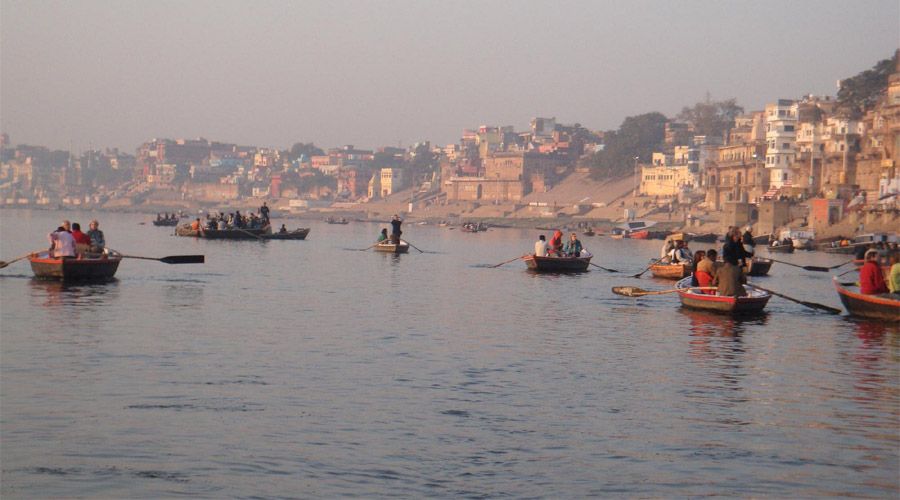Varanasi, one of the world’s oldest continuously inhabited cities, is known as the spiritual capital of India. Nestled on the banks of the sacred river Ganga, the city is home to more than 80 ghats, each with its own history, mythology, and spiritual significance. Among these, Pancha Ganga Ghat holds a special place. It is not just a flight of steps leading to the river but a sacred confluence of faith, history, and devotion. The very name “Pancha Ganga” signifies the presence of five holy rivers merging here—Ganga, Yamuna, Saraswati, Kirana, and Dhutapapa—making it a site of immense religious importance for Hindus.
Historical Significance
The history of Pancha Ganga Ghat dates back centuries. According to Hindu scriptures, this ghat is considered one of the most sacred spots in Kashi (Varanasi). It is believed that bathing in its waters cleanses devotees of their sins and grants them liberation from the cycle of birth and death.
The ghat is closely associated with many saints and seers. Kabir, the great poet-saint of the 15th century, is said to have spent time here in deep meditation and spiritual discourse. Similarly, Tulsi Das, the author of the Ramcharitmanas, is also believed to have visited this ghat. Over time, the site became a spiritual hub for scholars, ascetics, and seekers of truth.
During the Mughal period, Raja Man Singh of Amber constructed significant structures at the ghat. Later, Aurangzeb, the Mughal emperor, demolished several temples here, including the grand Bindu Madhav Temple. A mosque, known as the Alamgir Mosque or Beni Madhav ka Darera, was built on its ruins. Despite these turbulent times, the ghat retained its sanctity and continued to attract pilgrims from across the country.
The Legend of Five Rivers
The name “Pancha Ganga” (five rivers) arises from a deep-rooted legend. It is said that five sacred rivers—Ganga, Yamuna, Saraswati, Dhutapapa, and Kirana—meet spiritually at this very point. Although only the Ganga is visible to the eye, the others are believed to flow beneath the surface, unseen but eternally present.
This confluence is compared to the Triveni Sangam in Prayagraj, where three rivers meet. Devotees believe that taking a dip in the holy waters of Pancha Ganga Ghat brings blessings equivalent to bathing at multiple sacred confluences across India.
Architectural Features
Pancha Ganga Ghat has a fascinating blend of Hindu and Mughal architectural elements. The most striking structure here is the Alamgir Mosque, built by Aurangzeb on the remains of the destroyed Bindu Madhav Temple. The mosque, with its towering minarets and domes, stands as a prominent landmark. Interestingly, it overlooks the sacred river, creating a unique juxtaposition of faiths.
Despite the mosque’s presence, Hindus continue to revere the site deeply. Small temples and shrines dedicated to Lord Vishnu, Shiva, and other deities can be seen around the ghat. The steps leading down to the river are wide and inviting, often crowded with devotees performing rituals, offering prayers, or simply sitting in meditation.
Spiritual Importance
Pancha Ganga Ghat is especially important during religious festivals and rituals. Thousands of pilgrims gather here during Dev Deepawali, Kartik Purnima, and Makar Sankranti to take holy dips in the river. Priests conduct elaborate pujas and aartis, creating an atmosphere filled with chants, the fragrance of incense, and the flicker of oil lamps.
It is also a place where one can witness the Ganga Aarti, although less grand than the famous one at Dashashwamedh Ghat. Still, the spiritual energy here is profound and often described as more peaceful and meditative compared to the bustling crowds elsewhere.
Many people also come to the ghat to perform shraddha rituals (ancestral rites). The belief is that offering prayers to ancestors here ensures their liberation and blessings for the family.
Cultural Vibe
What makes Pancha Ganga Ghat unique is not just its religious appeal but also its cultural essence. On any given day, you can find a mix of locals, priests, students, and foreign tourists soaking in the atmosphere. Saints and sadhus often sit on the steps, chanting mantras or engaging in philosophical discussions.
The ghat has long been a hub for spiritual learning and exchange of ideas. In the past, it was common to see gatherings of poets, scholars, and ascetics who debated on scriptures and philosophies here. Even today, it remains a melting pot of traditions, stories, and spiritual practices.
Nearby Attractions
Pancha Ganga Ghat is located close to several other significant ghats and temples of Varanasi. Visitors can easily explore:
- Dashashwamedh Ghat – Famous for its grand Ganga Aarti.
- Assi Ghat – Popular among young travelers and seekers of peace.
- Kashi Vishwanath Temple – One of the most sacred temples dedicated to Lord Shiva.
- Tulsi Ghat – Associated with the poet-saint Tulsidas.
A walk along these ghats provides a panoramic view of Varanasi’s spiritual and cultural landscape.
Experiencing Pancha Ganga Ghat Today
For modern-day travelers and pilgrims, Pancha Ganga Ghat offers an experience that goes beyond sightseeing. It is a place to pause, reflect, and immerse oneself in the timeless rhythm of Varanasi. Watching the sunrise from the ghat, as the river glows golden and devotees chant hymns, is a memory that lingers long after leaving the city.
Whether you are a devotee seeking blessings, a history enthusiast exploring Mughal and Hindu legacies, or a traveler eager to experience India’s spiritual core, Pancha Ganga Ghat is a destination that speaks to the soul.
Conclusion
Pancha Ganga Ghat is more than just stone steps leading to the Ganga—it is a living testament to India’s spiritual traditions, resilience, and cultural diversity. The stories of saints, the legends of sacred rivers, the architecture of bygone eras, and the devotion of countless pilgrims make it a sacred space where history and divinity coexist. Visiting this ghat is not just a journey through the lanes of Varanasi but also a journey inward, toward self-discovery and peace.



